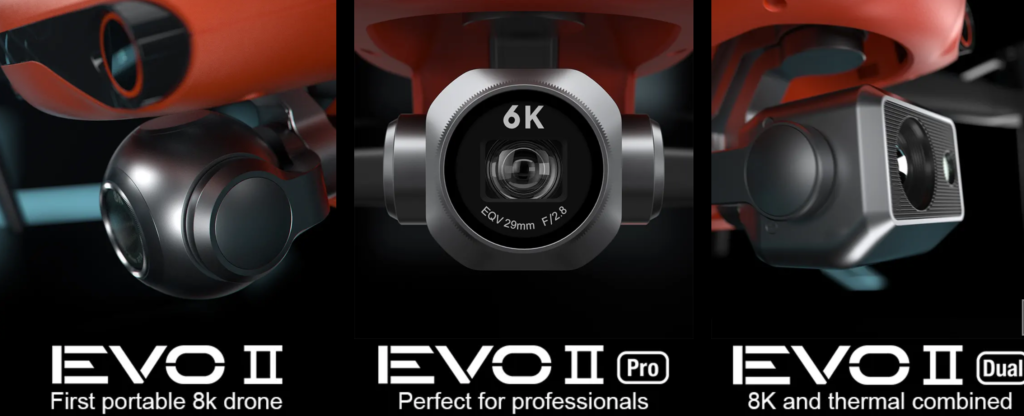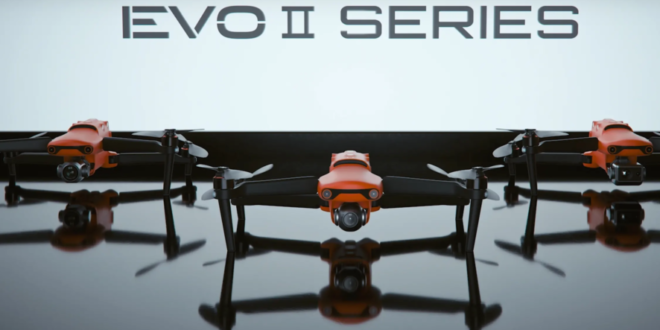When a product launch makes a big splash in the drone industry, either the bar has been raised or an unlucky pilot has flown a GoPro Karma too close to a lake.
Bold first impressions are hard to come by because new drones tend to be iterations. Small and steady improvements on older models.
Looking back, there are only a handful of unveilings that have changed the landscape in an instant: The Phantom 4 and its obstacle avoidance tech in 2016. The foldable Mavic Pro a few months later. The Skydio R1 and its industry-leading autonomy, which has since been followed by another standard-setting drone, the Skydio 2.
At CES last week, what felt like another big moment came from an unexpected source: Autel Robotics.
If you missed the news amid the usual avalanche of unveilings from Las Vegas, Autel’s new EVO 2 Series boasts some incredible specifications: a modular, foldable platform with 40 minutes of flight time; omnidirectional obstacle avoidance, and the pièce de résistance: an 8k video camera.
The company’s calling it “The evolution of flight“. It’s certainly very impressive on paper.
The Evo II Series – What do we know so far?
The first thing to note about the new Evo 2 Series is that it really is a series. At CES, Autel announced three Evo II drones, the Evo II, the Evo II Pro and the Evo II Dual. All three drones are based on the same foldable airframe, so have the same performance specifications. The difference is in the payloads, which can be swapped out in a couple of minutes.
This is great news for pilots who want a single, modular and multifunctional platform, rather than a separate drone for inspections, mapping and cinematography.
So what do all three drones have in common? Here are the key specs:
- Range: Up to 5.5 miles
- Internal storage: 8GB
- Controller: Built-in screen, as well as the ability to plug in a phone
- Flight time: 35-40 minutes
- Safety: 12 computer vision sensors for omnidirectional obstacle avoidance
- Max speed: Standard is 15m/s, Ludicrous Mode is 20 m/s
All three models can follow subjects autonomously while dodging obstacles at high speed, using Autel’s Dynamic Track 2.0. The platform’s object detection recognizes up to 64 subjects at once including people, vehicles, and animals.
And here are the camera specs for the three different payload variations:
Evo II
- 8k video
- 1/2″ CMOS sensor
- 48 million effective pixels
- ISO Range: 100-3200
- Max resolution: 8000×6000
- Bitrate: 120mbps, 10-bit
Evo II Pro
- 6k video
- 1″ CMOS sensor
- 20 million effective pixels
- ISO range: 100-12800
- Max resolution: 5472×3648
- Bitrate: 120mbps, 10-bit
- Adjustable aperture: f/2.8-f/11
Evo II Dual
- Sensors: 1/2″ CMOS + FLIR LWR
- ISO: 100-3200
- Max Resolution: 8000×6000 (visual), 640×512 (IR)
- Bitrate: 120mbps, 10-bit

At first glance, you might be wondering why the standard Evo II shoots higher resolution footage than the Pro version. The devil is in the detail. It’s likely that professional cinematographers will choose the Sony IMX383 1-inch sensor and adjustable aperture over the 8k video.
Can Autel’s Evo 2 Series compete with DJI and Skydio?
The big question is to what extent Autel can take a chunk out of DJI’s market share, while competing with Skydio – which looks set to make significant inroads in 2020.
With the advent of an 8K camera on a foldable drone, Autel’s Evo 2 Series has a USP no other manufacturer can currently match. The modularity we’ve seen from Autel before is also a positive selling point that provides an avenue for solid ROI for pilots thinking about the value for money on offer.
Then there are the flight time and the obstacle sensing capabilities. So far we only have the company’s word to go on, but anything close to the 40 minutes promised would set a new standard for a drone of this size.
Autel has also suggested that the Evo 2’s 12 obstacle-avoidance sensors make it as good at dodging obstacles as the Skydio R1 – which is a big and exciting claim.
The price point also looks set to be highly competitive. The Evo II will cost around $1,500, more expensive than the Skydio 2 ($999) but undercutting the DJI Mavic 2 Pro ($1,729).
Read more: Skydio CEO Adam Bry on Autonomy, Scaling Up & Taking on DJI
All of which appears to put the Evo II in a strong position to lure would-be buyers from both DJI and Skydio.
If the Evo II matches the R1 for computer vision an autonomous flight, it’s smarter than anything DJI can bring to the table. And if the 8k and 6k cameras perform as we’d expect, it’s going to be a compelling proposition for cinematographers.
The modularity, price and flight time all add to the package.
The real challenge will be brand loyalty. Convincing former DJI pilots to switch sides will not be easy, no matter how compelling the specifications. Building good drones isn’t easy, and what looks amazing on paper can be a challenge to bring to market.
Autel Robotics Evo II Series: Price and Availability
Having said that, Autel’s latest drones are already in production and the company expects Evo II to start shipping in a matter of weeks. Pricing isn’t final yet, but according to The Verge, Autel has claimed the EVO II will cost around $1,495 and the EVO II Pro will cost around $1,895.
It looks like 2020 s going to be interesting.
Malek Murison is a freelance writer and editor with a passion for tech trends and innovation. He handles product reviews, major releases and keeps an eye on the enthusiast market for DroneLife.
Email Malek
Twitter:@malekmurison
Subscribe to DroneLife here.
https://dronelife.com/2020/01/13/autel-evo-ii-series-shake-up-drone-market/
 Unmanned Aerial Vehicle The latest drone news
Unmanned Aerial Vehicle The latest drone news




